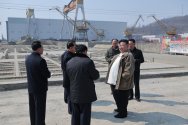Discussion: While North Korea's naval ambitions are clear, it does not appear to have gone far enough to modernize or replace the backbone of its fleet of hundreds of aging gunboats, fast attack craft and patrol boats.
Kim Jong Un has his sights set on nuclear-powered submarines and large surface combatants... cool, but what about the swarms of P-6 torpedo boats and Chongjin-class gunboats? Will they be replaced, upgraded, or simply continue to exist because they... haven't sunk (yet)?
I mean, they clearly have the technology and even designs available domestically or easily accessible from abroad (Russia, China, Iran, etc.), they've even built a few of them... but they don't seem to be aiming to upgrade the entire fleet in any significant way. Like the VSV crafts have been built by the dozens, but torpedo boats continue to be in service.
I think we will see these upgraded in the future, but it might be a while because missiles have a priority.
North Korea is probably in a mode of national emergency, roughly similar to how the US declared its own national emergency when they intervened in the Korean War that allowed them to start pumping enormous amounts of money into weapons development in order to expand their nuclear arsenal. The threat of US invasion is just too high (in the eyes of Kim Jong-un and other North Korean officials) so missiles are probably 100% priority right now.
Once both the strategic and tactical missile forces are more robust, we will probably see mass production of modern conventional weapons begin.
Note that while a number of advanced armored fighting vehicles have been shown off in recent parades (like the Chonma-2) there is no sign they are entering widespread service. In contrast, it is known that 250x Hwasong-11D TELs have been delivered for frontline service.
It is also possible the navy has less of a priority even amongst all service branches, or that its role is being redesigned within North Korean doctrine. Previous doctrine, I would assume, was based on defeating an Incheon-style amphibious landing. Now that nuclear weapons are the center of the new doctrine, it is possible the navy is being entirely geared towards nuclear warfare. In this case, ASW platforms make more sense than anti-surface vessels like torpedo boats and missile craft, for the purpose of protecting SSBs or SSBNs.
Of course the coastal defense role is still important, but I would guess that this might be handed over to coastal artillery, which are due to be upgraded with the Padasuri-6 shore-based ASM that was tested last year. A single TEL alone can carry 8 missiles. Realistically, a TEL is also a much better option in the present day than a fast attack craft. Not only is a TEL much easier to maintain than a ship, TELs can disperse and hide much better than fast attack craft, which are limited by the number of ports North Korea has. Even when they do attack, they have to sail out at sea and can be easily spotted by MPAs or AWACS, while a TEL can remain well hidden and even survive to fire further salvoes.
I think a more interesting option for the existing fast attack craft would be to potentially convert them to large USVs, roughly similar to how China has converted J-6s to drones. Ukraine has scored some successes with such drones. The large size of the vessels would make them more suited to decoys. That said, it might not be worth the expense.



